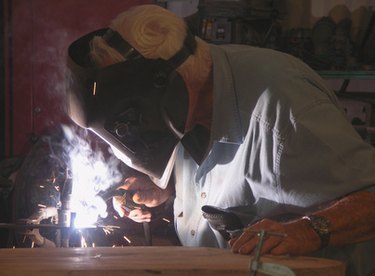
Welding rods often utilize alloys of several materials. According to online welding informational resource Welding Technology Machines, the three most common welding rods allow for joining or building up various steel alloys: copper coated mild steel alloy, high carbon steel alloy and 3 percent nickel steel alloy. There is an exhaustive list of materials used in the creation of steel welding rods, and rods also exist for aluminum, copper and various other metals and alloys.
Copper Coated Mild Steel Alloy
Video of the Day
Copper coated mild steel alloy comprises the most popular welding rod styles, according to Welding Technology Machines. Copper coated mild steel welding rods commonly see use for mild, low carbon, steel and wrought iron welding purposes. Mild steel, the most common steel, costs comparatively little in the world of steel; because of this, mild steel sees more use than any other form of steel. Copper coatings stop the corrosion and rust from which exposed mild steel needs protection. Copper coated mild steel alloy welding rods melt at 2,714 degrees Fahrenheit. Rods made of this material require no flux--a welding material designed to hinder oxidation and improve weld strength--for welding.
Video of the Day
High Carbon Steel Alloy
High carbon steel alloy welding rods rank second as the most common welding rod, states Welding Technology Machines. High carbon steel alloy welding rods require flux during welding. According to welding materials supplier Aufhauser, flux plays an important role in most welding processes. High carbon steel often builds up or repairs cutting edges, and several bicycle companies manufacture frames with high carbon welded steels. High carbon steels often form springs for a variety of applications as well. High carbon steel alloy rods melt at 2,462 degrees Fahrenheit. Welding rods of this material resist corrosion far better than mild steels and require no copper coating.
3 Percent Nickel Steel Alloy
Steel, typically a combination of iron and carbon, often increases hardness with the addition of alloy materials such as molybdenum, chromium or nickel. Welders use 3 percent nickel steel alloy welding rods more often than any other rods except copper coated mild steel alloy rods and high carbon steel alloy rods, according to Welding Technology Machines. Often used in the automotive industry, 3 percent nickel steel alloy welding rods build up worn camshafts, shafts and gears. Three percent nickel steel alloy welding rods require flux during welding and melt at 2,642 degrees Fahrenheit. Welding rods of this material resist corrosion well and require no copper coating.